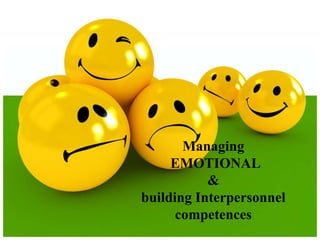emotions moods
•Download as PPTX, PDF•
2 likes•2,002 views
This document discusses emotions and emotional intelligence. It defines emotion and emotional intelligence, including the ability to identify, assess, and control one's own emotions and those of others. It identifies common emotions like happiness, surprise, disgust, fear, anger, and sadness. It also discusses gender differences in emotional expression and emotional labor. The four attributes of emotional intelligence are identified as self-awareness, self-management, social awareness, and relationship management. The document notes how emotional intelligence can affect performance, health, relationships, and applications in organizations like decision making, creativity, motivation, leadership, conflict, negotiation, and customer service.
Report
Share
Report
Share

Recommended
Recommended
More Related Content
What's hot
What's hot (20)
Increase Your Emotional intelligence-Basics for Beginners

Increase Your Emotional intelligence-Basics for Beginners
Similar to emotions moods
Bagali, MM / HR as subject / Publication / Research paper publication / / HR/ HRM/ HRD/ ....OB and HRM.....Emotions 2015.....Bagali, MM / HR as subject / Publication / Research paper publication / / H...

Bagali, MM / HR as subject / Publication / Research paper publication / / H...dr m m bagali, phd in hr
Similar to emotions moods (20)
presentationonemotionalintelligence-130810001034-phpapp01 2.pdf

presentationonemotionalintelligence-130810001034-phpapp01 2.pdf
Bagali, MM / HR as subject / Publication / Research paper publication / / H...

Bagali, MM / HR as subject / Publication / Research paper publication / / H...
Emotional Intelligence, Goleman's Theory, Emotional Intelligence in work plac...

Emotional Intelligence, Goleman's Theory, Emotional Intelligence in work plac...
Recently uploaded
Recently uploaded (8)
BHOLENDRA SINGH RESUME - Sr. Software Engineer at India Today Group

BHOLENDRA SINGH RESUME - Sr. Software Engineer at India Today Group
Rally Webinar: Employer Brand Campaigns that Attract and Retain.pdf

Rally Webinar: Employer Brand Campaigns that Attract and Retain.pdf
Unlocking Employee Potential with the Power of Continuous Feedback

Unlocking Employee Potential with the Power of Continuous Feedback
Boost Efficiency with an Inventory Tracking Spreadsheet.docx

Boost Efficiency with an Inventory Tracking Spreadsheet.docx
emotions moods
- 2. WHAT IS EMOTION ? • is the ability to identify, assess, and control the emotions of oneself, of others, and of groups. It can be divided into ability EI and trait EI. • Criticisms have centered on whether EI is a real intelligence and whether it has incremental validity over IQ .
- 5. Happiness Happiness is a positive emotion. It is an expression of pleasure, contentment, good- luck or good fortune.
- 6. Surprise An expression used when something unexpected or sudden occurs. POSITIVE
- 7. Disgust Disgust is a strong feeling of dislike. Negative.
- 8. Fear A feeling that something dreadful or dangerous is about to happen. Negative
- 9. Anger Anger is a strong feeling of annoyance and displeasure. Negative
- 13. Gender and Emotions • Women – Can show greater emotional expression – Experience emotions more intensely – Display emotions more frequently – Are more comfortable in expressing emotions – Are better at reading others’ emotions • Men – Showing emotions is inconsistent with the male image – Are less able to read and to identify with others’ emotions – Have less need to seek social approval by showing positive emotions
- 14. Emotional Labor • A situation in which an employee expresses organizationally desired emotions during interpersonal transactions. • Emotional dissonance—Inconsistencies between the emotions we feel and the emotions we project.
- 15. WHAT IS EMOTIONAL INTELLIGENCE? • Emotional intelligence (EQ) is the ability to IDENTIFY, UNDERSTAND, and MANAGE EMOTIONS in positive ways to relieve stress, communicate effectively, empathize with others, overcome challenges, and defuse conflict.
- 16. Emotional Intelligence Consists Of Four Attributes • Self-awareness – You recognize your own emotions and how they affect your thoughts and behavior, know your strengths and weaknesses, and have self- confidence. • Self-management – You’re able to control impulsive feelings and behaviors, manage your emotions in healthy ways, take initiative, follow through on commitments, and adapt to changing circumstances.
- 17. • Social awareness – You can understand the emotions, needs, and concerns of other people, pick up on emotional cues, feel comfortable socially, and recognize the power dynamics in a group or organization. • Relationship management – You know how to develop and maintain good relationships, communicate clearly, inspire and influence others, work well in a team, and manage conflict.
- 18. Emotional Intelligence Will Affects 1. Your performance at work 2. Your physical health 3. Your mental health 4. Your relationships
- 19. OB Applications of Emotions and Moods • Emotions and Selection – Emotions affect employee effectiveness. • Decision Making – Emotions are an important part of the decision-making process in organizations. • Creativity – Positive mood increases creativity. • Motivation – Emotional commitment to work and high motivation are strongly linked.
- 20. OB Applications of Emotions and Moods • Leadership – Emotions are important to acceptance of messages from organizational leaders. • Interpersonal Conflict – Conflict in the workplace and individual emotions are strongly intertwined. • Negotiation – Emotions can impair negotiations. • Customer Services – Emotions affect service quality delivered to customers which, in turn, affects customer relationships.
